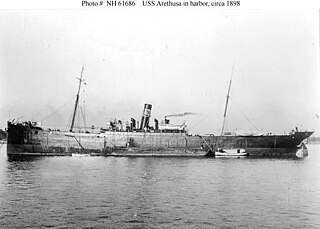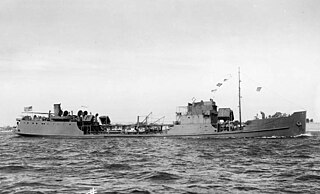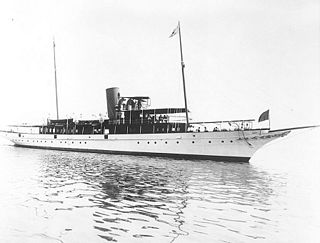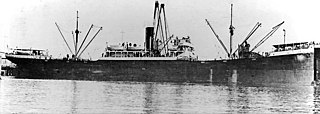
USS Arethusa (AO-7) was a steamship that was built in England in 1893 as the civilian oil tanker Luciline. The United States Navy bought her in 1898, and later had her converted into a Fleet oiler. She was sold back into civilian ownership in 1927, and by 1928 she was a civilian hulk in Boston.

Hammac was a steam tank ship built in 1920–1921 by Bethlehem Shipbuilding Corporation of Alameda for the United States Shipping Board as part of the wartime shipbuilding program of the Emergency Fleet Corporation (EFC) to restore the nation's Merchant Marine. Early in 1923 the vessel together with two other tankers was sold to General Petroleum Corporation and renamed Emidio. The tanker spent the vast majority of her career carrying oil along the West Coast of the United States as well as between West and East coast. In December 1941 she was shelled and damaged by the Japanese submarine I-17 and eventually wrecked with a loss of five crewmen.

USS Leonidas (AD-7) was a destroyer tender, the lone ship in her class, named for Leonidas I, and the second United States naval vessel to bear the name.

USS Guyandot (AOG-16) was a gasoline tanker acquired by the U.S. Navy as Veedol No. 2 from Tidewater Oil to serve as a gasoline tanker. The tanker served in Mediterranean operations often under air attack. After postwar decommissioning January 1945 in Algeria and service with the French under lend-lease the tanker was purchased in March 1949 by France serving under the name Lac Noir.

The auxiliary patrol vessel USS Yacona (SP-617) was built in 1898 in Scotland as a civilian steam yacht of the same name. Later, she was renamed Amélia as a survey yacht of the King of Portugal, before reverting to Yacona in 1901. She was acquired by the U.S. Navy in September 1917 and served until 1919 as a patrol vessel in the western Atlantic. In 1921 she was transferred to the Philippines as the governmental yacht Apo, serving until 1932.
USS SC-255, sometimes styled as either Submarine Chaser No. 255 or S.C.-255, was an SC-1-class submarine chaser built for the United States Navy during World War I. Like most members of her class, she was not named and known only by her designation.
USS SC-142, sometimes styled as either Submarine Chaser No. 142 or S.C.-142, was an SC-1-class submarine chaser built for the United States Navy during World War I. Upon completion, she was transferred to the French Navy

USS SC-48, sometimes styled as either Submarine Chaser No. 48 or S.C.-48, was an SC-1-class submarine chaser built for the United States Navy during World War I. Like most members of her class, she was not named and known only by her designation.

USS Crystal (PY-25), built in 1929 as the yacht Cambriona for Walter O. Briggs of Detroit, Michigan, was a patrol yacht in the United States Navy. The Navy acquired the yacht in January 1942 as Vida commissioning the vessel as Crystal in February. Naval service was in Hawaii until November 1945. After sale in November 1947 the vessel operated commercially in Central and South America.

USS Nokomis (SP-609) was a yacht purchased by the U.S. Navy during World War I. The yacht was purchased from Horace E. Dodge of Detroit, Michigan, after he had the yacht luxuriously fitted out but before he could make use of his second Nokomis — the first having already gone into service.

USS Artemis (SP-593), launched as the steam yacht Cristina then upon sale the yacht was renamed Artemis. The yacht was purchased by the United States Navy during World War I and the name was retained. Artemis was armed with guns and depth charges and sent to Europe as a patrol craft to protect Allied ships from German submarines and other dangers. The patrol yacht was renamed Arcturus in 1918. Post-war, she was returned to the United States and turned over to the United States Coast and Geodetic Survey. Later, again Artemis, the vessel was in civilian operation until burning and sinking in 1927.

USS Galatea (SP-714/YP-714) was a steam yacht acquired by the U.S. Navy during World War I. She was outfitted as an armed patrol craft and served in the North Atlantic Ocean. At war's end she was used as a receiving ship in Portsmouth, New Hampshire, for submariners before being sold in 1921.

USS Majaba (AG-43/IX-102) was the Design 1049 cargo ship Meriden built in 1919 by the Albina Engine & Machine Works, Portland, Oregon. All the ships were requisitioned by the United States Shipping Board (USSB) for World War I service. The ship was bought by the E. K. Wood Lumber Co., of San Francisco, California in 1923 and renamed El Capitan. The ship was chartered by the U.S. Navy through the War Shipping Administration (WSA) in April 1942 and commissioned as Majaba.

Seisho Maru was a cargo ship for Mitsui Bussan Kaisho in military service that was sunk by an American submarine during World War II. The ship had been built as SS West Caruth, a cargo ship for the United States Shipping Board (USSB) shortly after the end of World War I. Shortly after completion, the ship was inspected by the United States Navy for possible use as USS West Caruth (ID-2850) but was neither taken into the Navy nor ever commissioned under that name. Before being sold to Japanese owners in 1928, she was also known as SS Exmoor and SS Antonio Tripcovich.

W. L. Steed was a steam tanker built in 1917–1918 by Bethlehem Shipbuilding Corporation of Quincy for Pan American Petroleum and Transport Company, with intention of transporting oil and petroleum products between Mexican and Gulf ports and the Northeast of the United States. The ship was briefly requisitioned by the US Government during World War I but returned to commercial service in early 1919. The ship was named after William L. Steed, superintendent of the Mexican Petroleum Company of California.
The first USS Indianapolis was a cargo ship that served in the United States Navy from 1918 to 1919.
Ruth Kellogg was a 5,037 GRT tanker that was built in 1920 as the Design 1025 Hog Islander Calaumet by American International Shipbuilding, Hog Island, Philadelphia, Pennsylvania, United States for the United States Shipping Board (USSB). Completed as Vaba, she was converted to a tanker in 1921. A sale in 1929 saw her renamed Ruth Kellogg. In 1940, she was transferred to the British Ministry of War Transport (MoWT). Renamed Empire Dolphin in 1941, she served until 1947 when she was scrapped.

USS Arctic (SP-1158) was a wooden-hulled steam tug acquired by the US Navy during World War I. Arctic was briefly employed as a convoy escort during the war and later used to tow targets and transport ammunition. She was returned to commercial service in 1919.

The San Clemente-class oil tanker is a class of oil tankers built by National Steel and Shipbuilding Company (NASSCO), San Diego. The size places them in the category of super tankers. They were built to serve the Trans-Alaska Pipeline System. At the time of completion National Steel and Shipbuilding Company was equally owned by Kaiser Industries Corporation and Morrison-Knudsen Company, Inc.

American Petroleum Transport Corporation was an oil shipping company founded in New York City in 1936. Daniel K. Ludwig was President of American Petroleum Transport Corporation. In 1939 American Petroleum Transport Corporation operated eight tanker ships from the Gulf of Mexico to Hatteras, North Carolina. American Petroleum Transport Corporation was active in supporting the World War II efforts. Some tanker ships American Petroleum Transport Corporation operated were sunk by German U-boat submarines. Daniel K. Ludwig founded in 1936 the company National Bulk Carriers.















